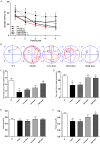The Mechanisms of Bushen-Yizhi Formula as a Therapeutic Agent against Alzheimer's Disease
- PMID: 29449587
- PMCID: PMC5814461
- DOI: 10.1038/s41598-018-21468-w
The Mechanisms of Bushen-Yizhi Formula as a Therapeutic Agent against Alzheimer's Disease
Abstract
Bushen-Yizhi prescription (BSYZ) has been an effective traditional Chinese medicine (TCM) prescription in treating Alzheimer's disease (AD) for hundreds of years. However, the underlying mechanisms have not been fully elucidated yet. In this work, a systems pharmacology approach was developed to reveal the underlying molecular mechanisms of BSYZ in treating AD. First, we obtained 329 candidate compounds of BSYZ by in silico ADME/T filter analysis and 138 AD-related targets were predicted by our in-house WEGA algorithm via mapping predicted targets into AD-related proteins. In addition, we elucidated the mechanisms of BSYZ action on AD through multiple network analysis, including compound-target network analysis and target-function network analysis. Furthermore, several modules regulated by BSYZ were incorporated into AD-related pathways to uncover the therapeutic mechanisms of this prescription in AD treatment. Finally, further verification experiments also demonstrated the therapeutic effects of BSYZ on cognitive dysfunction in APP/PS1 mice, which was possibly via regulating amyloid-β metabolism and suppressing neuronal apoptosis. In conclusion, we provide an integrative systems pharmacology approach to illustrate the underlying therapeutic mechanisms of BSYZ formula action on AD.
Conflict of interest statement
The authors declare no competing interests.
Figures









Similar articles
-
Modulating endoplasmic reticulum stress in APP/PS1 mice by Gomisin B and Osthole in Bushen-Yizhi formula: Synergistic effects and therapeutic implications for Alzheimer's disease.Phytomedicine. 2023 Oct;119:155023. doi: 10.1016/j.phymed.2023.155023. Epub 2023 Aug 12. Phytomedicine. 2023. PMID: 37586159
-
Ethyl Acetate Extract Components of Bushen-Yizhi Formula Provides Neuroprotection against Scopolamine-induced Cognitive Impairment.Sci Rep. 2017 Aug 29;7(1):9824. doi: 10.1038/s41598-017-10437-4. Sci Rep. 2017. PMID: 28852153 Free PMC article.
-
Alleviating effects of Bushen-Yizhi formula on ibotenic acid-induced cholinergic impairments in rat.Rejuvenation Res. 2015 Apr;18(2):111-27. doi: 10.1089/rej.2014.1603. Rejuvenation Res. 2015. PMID: 25482164 Free PMC article.
-
Traditional Chinese Medicine for Alzheimer's Disease and Other Cognitive Impairment: A Review.Am J Chin Med. 2020;48(3):487-511. doi: 10.1142/S0192415X20500251. Epub 2020 Apr 24. Am J Chin Med. 2020. PMID: 32329645 Review.
-
Network Medicine for Alzheimer's Disease and Traditional Chinese Medicine.Molecules. 2018 May 11;23(5):1143. doi: 10.3390/molecules23051143. Molecules. 2018. PMID: 29751596 Free PMC article. Review.
Cited by
-
In silico Identification and Mechanism Exploration of Hepatotoxic Ingredients in Traditional Chinese Medicine.Front Pharmacol. 2019 May 3;10:458. doi: 10.3389/fphar.2019.00458. eCollection 2019. Front Pharmacol. 2019. PMID: 31130860 Free PMC article.
-
Qingxin Kaiqiao Recipe Improves Cognitive Performance, Inhibits Apoptosis, and Reduces Pathological Deposits in APP/PS1 Double Transgenic Mice via the PI3K/Akt Pathway.Evid Based Complement Alternat Med. 2020 Apr 28;2020:3019674. doi: 10.1155/2020/3019674. eCollection 2020. Evid Based Complement Alternat Med. 2020. PMID: 32419798 Free PMC article.
-
Involvement of Fgf2-mediated tau protein phosphorylation in cognitive deficits induced by sevoflurane in aged rats.Mol Med. 2024 Mar 16;30(1):39. doi: 10.1186/s10020-024-00784-0. Mol Med. 2024. PMID: 38493090 Free PMC article.
-
East Wind, West Wind: Toward the modernization of traditional Chinese medicine.Front Neurosci. 2022 Nov 10;16:1057817. doi: 10.3389/fnins.2022.1057817. eCollection 2022. Front Neurosci. 2022. PMID: 36440293 Free PMC article. Review.
-
Systems Pharmacological Approach to Investigate the Mechanism of Acori Tatarinowii Rhizoma for Alzheimer's Disease.Evid Based Complement Alternat Med. 2018 Jun 27;2018:5194016. doi: 10.1155/2018/5194016. eCollection 2018. Evid Based Complement Alternat Med. 2018. PMID: 30050590 Free PMC article.
References
Publication types
MeSH terms
Substances
LinkOut - more resources
Full Text Sources
Other Literature Sources
Medical
Molecular Biology Databases

